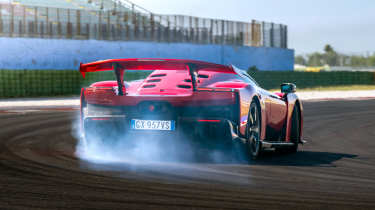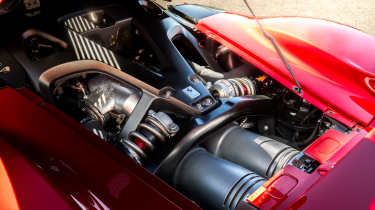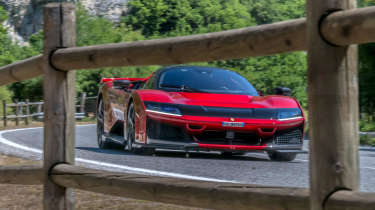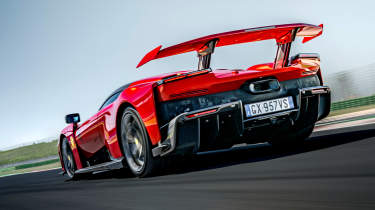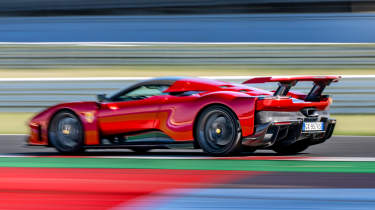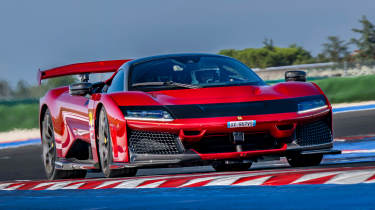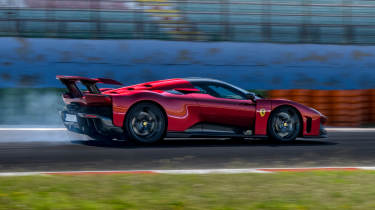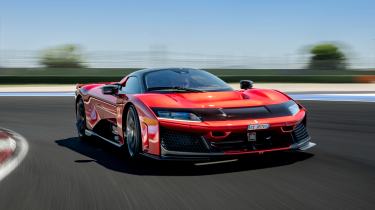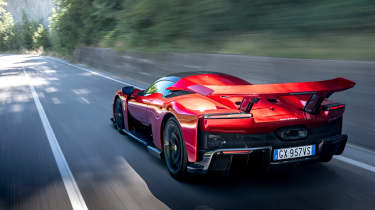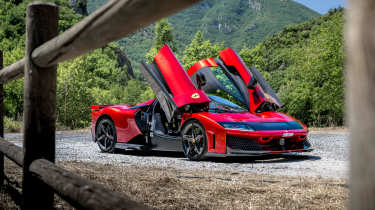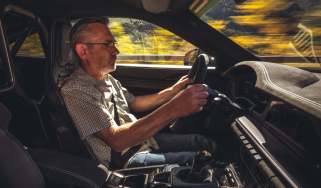Ferrari F80 2025 review – hybrid V6 hypercar is a worthy successor to the LaFerrari
The near-1200bhp F80 is a bold leap into the future, but does it deliver the seductive driving experience we expect of a Maranello special?
The apex supercar is at a crossroads. If you’re Gordon Murray, you build the lightest, purest, most analogue car you can. If you’re Bugatti, you build a grandiose behemoth of blinding speed and dazzling mechanical complexity. If you’re Pagani, Koenigsegg, Lamborghini or Hennessey you build something that sits somewhere in between. And if you’re Ferrari? Well, you build this, the ultra-contemporary F80.
The latest in Maranello’s storied bloodline of special-series cars, the F80 can trace its ancestry back four decades to the delectable 288 GTO. In the F40, F50, Enzo and LaFerrari that followed, Ferrari created a dynasty of supercars charting the most significant automotive advancements of their day. From turbocharging and nascent aerodynamics, to lightweight composites, F1 technology transfer and hybrid powertrains, each chapter has been a stepping stone towards a bold future. One which has exerted an increasing influence over the series-production cars that followed.
The £3m (plus taxes) F80’s headline stats are well known but worth repeating. Foremost amongst the key numbers is the twin-turbocharged, 120-degree F163CF V6 hybrid powertrain’s combined output of 1183bhp (1200 PS); 888bhp from the V6, the rest from a trio of electric motors. The V6 achieves its epic, near 300bhp-per-litre output thanks to a 20 per cent higher compression ratio than the related unit in the 296 GTB. There’s also the latest anti-knock control, which prevents damaging premature ignition of the fuel-air mixture. A pair of e‑turbos – a first for Ferrari – offer the win-win of greater boost capacity with no penalty in terms of low-rev/low-boost response.
More reviews
The remaining 295bhp of that peak figure is shared between the twin-motor electric front axle (e‑4WD) and a single electric motor (MGU‑K) sandwiched between the V6 and the gearbox. The F80’s motors are the first Ferrari has designed and manufactured in-house. The company has developed its own converter that can step down the voltage from the full 800V supplied by the battery array to the 48V required by the active suspension and e‑turbo systems, and to 12V for power the numerous ECUs and other electrical ancillaries. The batteries have also been developed by Ferrari. Using lithium-cell chemistry derived from F1, the battery unit is built around a carbonfibre monocoque casing and tightly packaged to save space and weight.
Top speed? 217mph. 0-62mph? 2.15sec. 0-124mph? 5.75sec. Weight? 1525kg dry with ‘optional’ content, which includes exposed carbonfibre bodywork, chassis and wheel rims. Ferrari says that in total these options save circa 30kg, so not as significant as the 100kg or so that can be saved on a series-production Ferrari by choosing the lightest options.
We all got very hung up on the F80’s lack of engine noise, didn’t we? And, just as emotively, its lack of cylinders. Despite Ferrari’s F1 and WEC race cars being powered by hybrid V6s, so much is attached to the prestige and tradition of the V12 that anything less is seen as second-rate. And so, for the most part, we hated on the F80 on principle. For no other reason than it seemed to be a betrayal of all that’s sacred in supercar lore.
Such is the double-edged nature of Ferrari’s pre-eminent position as the greatest of all car makers. Tradition is certainly a cornerstone of what we know to be Ferrari, but increasingly that tradition has been one of technological advancement. So if the F80 were to be true to the well-established convention of Ferrari’s special-series cars, it had to be a bold stride into the future and not a repeat of familiar tropes.
Still Ferrari explored many options for what the F80 could be, with V12, V8 and even a full EV powertrain thoroughly evaluated. In the end the 120-degree V6 was chosen because it delivered the most power with the greatest efficiency. Moreover, the compactness of the wide-angle V6 meant it could unlock tremendous aerodynamic performance.
The F80 was conceived and developed in parallel with Ferrari’s World Endurance Championship programme. That car became the all-conquering 499P – now fresh from an extraordinary hat-trick of Le Mans 24 Hour wins – so the similarities in powertrain, layout and aerodynamic philosophy are truly authentic.
The 449P had to comply with strict and prescriptive technical regulations, but the F80 has been afforded far more freedom. No limits on power, the very latest ABS braking and stability control technology, active suspension and active aerodynamics. The most significant constraint was that which Ferrari imposed upon itself; namely that the F80 should be blisteringly quick on track, but also brilliantly capable and entertaining on the road. Making a distinction between uncompromising and uncompromised might seem like a game of semantics, but it’s the difference between a Valkyrie-style approach, which hits the highest of dynamic highs but is hobbled by a minuscule fuel tank and horrendous cockpit noise levels, and a car which more readily acknowledges the realities of road use.
After a long and detailed briefing video we walk around a part-built display car. The skeletal machine is fascinating to pore over, the changing patterns of the exposed carbon structure showing the points where tightly woven, high-strength material meets the lighter, chequerboard-like sections where weight saving is more important. The engine sits absurdly low, the bottom of its dry-sump block but millimetres from the topside of the full-length carbon floor. It’s also tilted slightly towards the nose so that the diffuser can be deeper and longer. At 1.8 metres in length the diffuser is some three times longer than the LaFerrari’s. There are no Valkyrie-style tunnels, but downforce combined with precise management of hot and cold airflow to critical areas of the car is deeply impressive.
A radical nose treatment harnesses a tri-plane S-duct system heavily influenced by the 499P. At the rear a large active wing deploys into the airstream on powerful rams and can adjust its rake by 22 degrees, tilting by +11 degrees in High Downforce mode and -11 degrees in Low Drag mode. All the active aero is fully automated with no manual override available to the driver.
Amongst the most beautiful of the F80’s components are the 3D-printed suspension ‘arms’, which are actually spindly, soft-edged webs of powdery alloy. Manufactured in-house at Maranello, these organic forms are in stark contrast to the hefty cast and machined bottom arms and point to the more extensive use of 3D printing in future production models.
Uniquely for a special-series car, the F80 media test isn’t being held at Fiorano. Instead, it’s at Misano. Famous for MotoGP and World Superbike events, the circuit boasts a wider variety of corners – from tight second-gear hairpins to a sixth-gear 150mph kink – and longer straights to stretch the F80’s legs. It’s a watershed moment, Ferrari tacitly admitting its latest creation has outgrown the famous test track on which so many of its forebears were developed.
Our track sessions begin with a passenger ride alongside Ferrari test and development driver, Francesco Comand. It’s predictably impressive – a blur of immense and sustained acceleration, unbelievably intense braking and neck-straining cornering. It’s also very necessary, for without such a vivid demonstration of the F80’s outright capabilities I’m not sure it would be possible to push meaningfully hard in the three five-lap sessions we’re allocated.
There’s no concealed door button to push or protruding handle to grab. Instead, you reach three-quarters of the way down the door and slot your fingers against the softly sprung flush-fit flap. Door released, it swings up and out on gas struts, taking a section of roof with it for easier ingress. It’s actually very easy to drop into the driver’s seat: just shimmy your hips down and swing in your legs with no need to fold them up awkwardly over the sill.
The cockpit is what Ferrari describes as a ‘1+’ layout. The passenger seat – fixed to the firewall and non-adjustable – is set slightly behind the driver’s seat, in echelon, if you will. It works really well for both occupants, the driver feeling like they’re in a zone of their own, passenger tucked out of the way but still getting a fabulous view of the driver at work and the world beyond the windscreen.
The interior is genuinely fabulous. Clean, simple, precise and comfortable. It’s pared back, but not bare like that of the SF90 XX, with fewer large expanses of exposed carbon for a slightly more luxurious feel. Headroom is decent even with a helmet, though you realise how much lower the central section of roof is if you try and lean across towards the passenger side. Clonk!
The oblong steering wheel is a masterpiece, the rim just fat enough to fill your hands and a new smaller boss affording a better view of the instrument display. Oblong wheels usually feel like steering with a Toblerone, but each of the F80 wheel’s corners is smoothed to perfection.
On the wheel is the usual combination of the regular Manettino for selecting the dynamic mode and an eManettino for the powertrain settings, plus the small arrow pad for scrolling through the infotainment system. This now has physical switches for up, down, left, right and confirm.
Our laps are completed with the hybrid system’s new Boost Optimisation function engaged. Available when Performance or Qualify is selected on the eManettino, this uses GPS data gathered on an initial recon lap to learn the circuit, before calculating where the best points are to deploy hybrid assistance. In Performance mode it maintains electric boost deployment at a sustainable level, so the batteries are never drained; in Qualify it wrings every last drop from the batteries in one lap.
To be completely honest it takes two of the three sessions to feel like I’m working the F80 hard enough. Not because it’s tricky to drive – quite the contrary – but because you need a while to understand just how hard you can work it in the braking areas, and how you can extend these braking areas deep into the heart of each corner.
In this respect the F80 is like a race car in that it only clicks when you can string the braking, corner entry and initial throttle application together into one delicious, seamless process. Brake too soon and, most likely, too softly and you find yourself becalmed way before your turn-in point and needing to get back on the power. Trust in the combined might of the F80’s new Brembo CCM‑R Plus brakes and ABS‑Evo control system and the way the F80 stops is mind-blowing. Pedal feel is fabulous – firm from the first millimetre of travel and consistent right up to the apex – and the resistance to an ABS intervention is extraordinary.
It’s the way you can pull such big longitudinal g and lateral g under braking that’s a bit mind-boggling, slowing right on the limit of the tyre (a Michelin Cup 2 R on these track F80s) with the front end pinned to your line and the rear resolutely following with no hint of breaking free and needing corrective inputs.
Central to this spooky capability is the active suspension system, which counters the forces of roll and pitch to maintain a stable platform, and therefore consistent aerodynamic downforce. It’s an evolution of the Multimatic system first seen on the Purosangue and operates with even greater precision and fidelity. The F80 has a feeling of serenity, even as you hear the Cup 2 Rs yelping under maximum braking, but there’s just enough initial movement to read the car and gauge how hard you’re working it. For such an unnaturally gifted car it feels impressively natural.
All this grip and stability encourages a modern geometric racing line rather than long, old-school arcs; brake late and deep, cut straight to the apex then straighten the car and punch out on all that combustion and battery torque. It’s prescriptive but very absorbing, the ease of operating the car allowing you more mental bandwidth to focus on nailing your braking points, trying to keep your minimum speeds as high as possible, and opening the steering to allow maximum acceleration with minimal nibbling from the traction control system.
Exiting the low-speed corners is an epic demonstration of the F80’s explosive straight-line pace, second, third and fourth devoured so rapidly it’s easy to catch the 9200rpm limiter despite the shift lights changing from red to blue as a visual prompt. The intensity fades a little in fifth thanks to the Boost Optimisation, which ensures you get maximum shove when and where it matters most (usually as early as possible in any acceleration phase).
Interestingly, and for the first time in a Ferrari, my fingers instructively reach for paddleshifters attached to the back of the steering wheel rather than the paddles fixed to the steering column. It’s an indication of how even through the tightest turns you never need to take your hands from the quarter-to-three position. If the fixed paddles were longer it might help, but race-car-style shifters on the wheel would be better.
As for high-speed corners, Misano’s kink is as formidable as they come. Easy flat in mortal machines, the F80 accrues such speed you’re approaching at 160mph-plus. At first it seems impossible to tackle it without braking, but by the final few laps it can be tackled with the gentlest brush of the brakes and – with a deep breath – a blend out of the throttle. Props to steely-nerved instructor Giampiero Simoni (yes, BTCC fans, that one) who sat alongside every journalist for their lapping sessions.
Weirdly, not only do the track sessions demonstrate the F80’s suitability for circuit driving, they also hint at a car that promises to be great on the road. It’s something we don’t have long to ponder, for early the next day we head into the hills for a morning on the road. No chaperones, just strict instructions to return by lunchtime.
The V6 sounded good with a crash helmet on but it sounds great when there’s nothing in the way. Gruff and respiratory, it’s pleasingly mechanical but also has some musicality that adds some warmth and ensures it’s not too droney on the autostrada. The gearbox is absolutely sensational. Immediate, near-seamless and with a wicked whipcrack report on full-throttle upshifts, it is without doubt the best DCT transmission I’ve ever experienced.
You can’t drive the F80 in electric-only mode – Ferrari didn’t feel that fitted the brief – so you’re always propelled by a blend of battery and combustion. It’s effortless on the autostrada, apparently bottomless reserves of high-gear, low-rev flex squeezing you towards the horizon on an invisible cord of elastic.
There’s some road noise transmitted from the tyres (F80-specific Cup 2s for our road-test element) through the suspension and into the tub, but it’s subdued enough to easily hold a conversation without having to raise your voice.
Body control is immaculate, but over rough urban surfaces the low-speed ride is a bit agitated. This despite there now being Hard, Medium and Soft settings available via the brilliantly simple ‘Bumpy Road’ button. I guess all things are relative when it comes to the ‘softer’ rates those track-capable active dampers allow. It’s the only slight downside to an otherwise fabulous chassis set-up.
The steering is quick and ultra-precise but has a perfect rate of response, so you seem to steer without conscious thought. Look at the apex and you find yourself there. It’s a magical sensation as you flow from corner to corner, no distracting noise from the steering, just a purity and consistency with none of the stodge that some EPAS systems have built-in in a misguided attempt to use weight as compensation for a lack of feel and connection.
It’s this connection that’s key to the F80’s success as a street car. I’d feared a car packed with such advanced technology and so reliant upon calibration to knit powertrain, brakes, suspension and aerodynamics seamlessly together might feel cold and contrived. Instead, the bond you form is intimate, intuitive and almost immediate. It’s a surprise. Not because there’s any reason to doubt Ferrari’s ability to harness advanced electronics, but because 1200bhp supercars with literally a ton of downforce are by their nature so well within themselves at road speeds and commitment levels.
Take your chance to fully uncork it and the F80 is insanely quick, but it’s not something you can sustain for more than an admittedly heart-pounding few seconds. It’s good to know the F80 has a wild side, but it’s the satisfaction you get from it at less banzai speeds that’s more important. The engine and gearbox are insanely well matched and give you such pleasure. The brakes have brilliant feel and response. The way you feel load build through the steering and chassis, while appreciating the lack of pitch and roll, ruins you for less gifted machinery. It is a high-fidelity driving experience in every single regard. One that’s unmistakably Ferrari, even though it does things in a way no Ferrari has ever done before.
We rightly celebrate the joys of great analogue supercars and have remained critical of technology where it fails to improve upon the finesse of skilled human hand-eye co-ordination or serves only to diminish the specialness of the driving experience. Our love affair with pure, simple analogue supercars will never fade, and rightly so, but the F80 shows that when deployed with conviction and honed to the nth degree, a supercar that relies upon mind-bendingly complex electronic systems can also be wholly seductive. Even one with a downsized engine that sounds more like a jet from the outside.
The F80 is a fascinating, stimulating, intoxicating car. An uncomfortable leap for sure, one that some will not wish to embrace, but still as authentic and appealing in 2025 as any of its predecessors were in their own eras. And as the prism through which the next generation of Ferraris will be directed, the F80’s significance will only grow. For just as the influence of the Enzo and LaFerrari was felt and seen in Ferrari’s greatest series-production cars of recent times, so this sixth chapter in the marque’s most compelling story will create its own legacy.
Ferrari F80 specs
| Engine | V6, 2992cc, twin-turbocharged, plus three e-motors (2 x 105kW front, 1 x 60kW rear) |
|---|---|
| Power | 1183bhp (combined) @ 8750rpm |
| Torque | 627lb ft (ICE only) @ 5550rpm |
| Weight | 1525kg (dry) |
| Power-to-weight | 788bhp/ton (dry) |
| Tyres as tested | Michelin Pilot Sport Cup 2 (road) and Cup 2 R (track) |
| 0-62mph | 2.15sec |
| Top speed | 217mph |
| Basic price | £3.6million |

